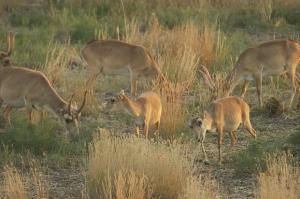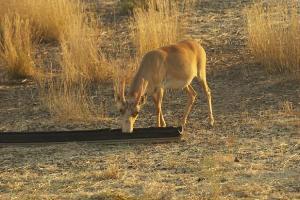Yuri Arylov
Other projects
The aim of our project is to establish a participatory monitoring programme for the Critically Endangered saiga antelope involving local people from the saiga range. This programme will have the dual benefit of both engaging local farmers in ecological monitoring, who will act as advocates for saigas in their communities, and of providing new knowledge to conservationists about saiga distributions.

Saiga herd in enclosure. © Anna Lushchekina.
The project aims to maintain the functioning of the Saiga Breeding Centre based at the Centre for Wild Animals of Kalmykia at Ermeli which is safe-guarding the North West pre-Caspian population of the critical endangered saiga antelope.

Saiga male near manger with grain. © Anna Lushchekina.
In 2000, the Government of the Republic of Kalmykia established the ‘Centre for Wild Animals of Kalmykia’ in order to preserve the siaga antelope, granting the Centre 800ha of pristine grassland for the construction of enclosures, an observation tower, a small house for living of animal keepers and a research laboratory to develop a programme of saiga captivity breeding.
The Centre now maintains more than 100 saigas and is the leading captive breeding facility. The Centre addresses the immediate and long term conservation needs for restoring the saiga’s range within the North-West pre-Caspian region by forming a protected captive breeding herd and re-introducing animals to the wild, as well as providing an important economic and educational opportunities for local people. The main activities of the Centre are maintaining and growing the saiga herd , boosting numbers in the wild herds, especially male saiga to reduce the demographic skew that is affecting saiga breeding performance. Research will continue into saiga ecology and steppe dynamics.
The Centre is also involved in community outreach work with an ongoing public awareness programme including lectures and excursions from the visitor centre. Nearby there are villages interested in promoting the traditional husbandry and sustainable use. Social surveys of these villages confirmed that with their help it is possible to establish a model farm which could produce traditional milk products, wool, meat and also handicrafts and local souvenirs, using pure blood fat-tail sheep and indigenous Kkalmyk cattle breeds. Demonstrating a successful business at the farm will attract rural people from neighbouring areas and provide the know-how for them to apply to their own lives, improving their livelihoods. Numerous eco-tourists and groups of students/school children regularly visiting the Centre will purchase these products and bring additional earnings to the farmers.